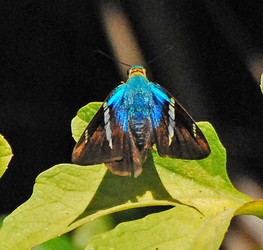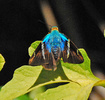Astraptes fulgerator complex
Andrew V. Z. Brower


This tree diagram shows the relationships between several groups of organisms.
The root of the current tree connects the organisms featured in this tree to their containing group and the rest of the Tree of Life. The basal branching point in the tree represents the ancestor of the other groups in the tree. This ancestor diversified over time into several descendent subgroups, which are represented as internal nodes and terminal taxa to the right.

You can click on the root to travel down the Tree of Life all the way to the root of all Life, and you can click on the names of descendent subgroups to travel up the Tree of Life all the way to individual species.
For more information on ToL tree formatting, please see Interpreting the Tree or Classification. To learn more about phylogenetic trees, please visit our Phylogenetic Biology pages.
close boxIntroduction
The eleven names in the Astraptes fulgerator complex correspond to the "ten species in one" identified from Guanacaste, Costa Rica on the basis of DNA barcodes but not formally described by Hebert et al. (2004). Brower (2006) performed more rigorous phylogenetic analyses of the mitochondrial cytochrome oxidase sequence data and corroborated at least four but probably not more than seven of these as distinct entities. To fix the "ten species" in nomenclature, Brower (2010) provided the names included here, diagnosing each taxon on the basis of unique combinations of nucleotide differences. It is likely that several of the names are synonyms of one another and/or of older names associated with geographical variants of Astraptes fulgerator. However, since it is impossible to determine which name corresponds to the type of A. fulgerator, eleven taxa are indicated here.
Discussion of Phylogenetic Relationships
The hypothesis of relationships is based on a cladistic analysis of the Hebert et al. (2004) DNA barcode sequences by Brower (2006). Given the small number of phylogenetically informative characters in this data set, the hypothesis should be viewed as extremely preliminary.References
Brower AVZ. 2006. Problems with DNA barcodes for species delimitation: “ten species” of Astraptes fulgerator reassessed (Lepidoptera: Hesperiidae). Systematics and Biodiversity 4: 127-132.
Brower, AVZ. 2010. Alleviating the taxonomic impediment of DNA barcoding and setting a bad precedent: names for ten species of 'Astraptes fulgerator' (Lepidoptera: Hesperiidae: Eudaminae with DNA-based diagnoses. Systematics and Biodiversity 8: 485-491.
Hebert PDN, Penton EH, Burns JM, Janzen DH, and Hallwachs W. 2004. Ten species in one: DNA barcoding reveals cryptic species in the neotropical skipper butterfly Astraptes fulgerator. Proc. Nat. Acad. Sci. USA 101: 14812-14817.
Title Illustrations

| Scientific Name | Astraptes fulgerator |
|---|---|
| Location | along the forest trails north of Sangayta, Nayarit, Mexico |
| Specimen Condition | Live Specimen |
| Source | WMex09_D-40-0101a |
| Source Collection | Flickr |
| Image Use |
 This media file is licensed under the Creative Commons Attribution-NonCommercial-ShareAlike License - Version 2.0. This media file is licensed under the Creative Commons Attribution-NonCommercial-ShareAlike License - Version 2.0.
|
| Copyright | © 2009 Jerry Oldenettel |
About This Page
Andrew V. Z. Brower

Middle Tennessee State University, Murfreesboro, Tennessee, USA
Correspondence regarding this page should be directed to Andrew V. Z. Brower at
abrower@mtsu.edu
Page copyright © 2010 Andrew V. Z. Brower
 Page: Tree of Life
Astraptes fulgerator complex.
Authored by
Andrew V. Z. Brower.
The TEXT of this page is licensed under the
Creative Commons Attribution-NonCommercial License - Version 3.0. Note that images and other media
featured on this page are each governed by their own license, and they may or may not be available
for reuse. Click on an image or a media link to access the media data window, which provides the
relevant licensing information. For the general terms and conditions of ToL material reuse and
redistribution, please see the Tree of Life Copyright
Policies.
Page: Tree of Life
Astraptes fulgerator complex.
Authored by
Andrew V. Z. Brower.
The TEXT of this page is licensed under the
Creative Commons Attribution-NonCommercial License - Version 3.0. Note that images and other media
featured on this page are each governed by their own license, and they may or may not be available
for reuse. Click on an image or a media link to access the media data window, which provides the
relevant licensing information. For the general terms and conditions of ToL material reuse and
redistribution, please see the Tree of Life Copyright
Policies.
- First online 28 December 2010
- Content changed 30 December 2010
Citing this page:
Brower, Andrew V. Z. 2010. Astraptes fulgerator complex. Version 30 December 2010 (under construction). http://tolweb.org/Astraptes_fulgerator_complex/145356/2010.12.30 in The Tree of Life Web Project, http://tolweb.org/







 Go to quick links
Go to quick search
Go to navigation for this section of the ToL site
Go to detailed links for the ToL site
Go to quick links
Go to quick search
Go to navigation for this section of the ToL site
Go to detailed links for the ToL site